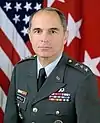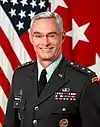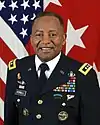
In September 2020, the Army realigned the previously consolidated CIO/G-6 function into two separate roles, CIO and Deputy Chief of Staff, G-6, that report to the secretary of the Army and chief of staff of the Army, respectively.[1] The realignment came after several months of planning and coordination.[2] Lt. Gen. John Morrison was nominated to the Senate for promotion and assignment as the G-6 and confirmed, assuming that position in August 2020.[3] The Department of the Army appointed Raj Iyer to serve as the chief information officer in November 2020.[4]
The United States Army chief information officer/G-6 (CIO/G-6) previously was a dual role, reporting both to the secretary of the Army as CIO, and also to the chief of staff of the Army as G-6.[5] The roles were realigned in 2020.[6]
As CIO
- Report directly to the secretary of the Army
- Set strategic direction and objectives for LandWarNet
- Supervise Army command, control, communications, computers, and IT (C4IT)
- Manage enterprise IT architecture
- Direct delivery of C4IT in support of warfighting and enterprise requirements
- Assess and ensure compliance of IT security and national security systems
As G-6
- Advise chief of staff of the Army on planning, fielding, and execution of C4IT worldwide Army operations
- Develop and execute the plan for the Global Enterprise Network
- Implement Army information assurance
- Supervise C4IT, Signal support, Information security, Force structure and equipping activities in support of warfighting operations
- Oversee management of the Signal forces
Planned realignment
On June 11, 2020, the Army announced that the two roles of CIO and Deputy Chief of Staff, G-6 (DCS, G-6) would be realigned no later than August 31, 2020, with separate individuals responsible for each position.[7] With the realignment:
- CIO core functions will be policy, governance, and oversight. Focus areas include: Information Environment, Cybersecurity, Enterprise Architecture, and Data Policy/Oversight/Governance, Enterprise Architecture, Enterprise Cloud Management and IT Spend/Category Management.
- DCS, G-6 core functions will be planning, strategy, and implementation. Focus areas include: Information Environment/Network, Planning and Integration, Theater Synchronization, Architecture Integration, Enterprise Information Environment (EIE) Mission Area Portfolio Management and Mission Decision Packet Management.
- In order to support multi-domain operations, the Army will have to connect Enterprise networks and tactical networks. —LTG Morrison, DCS, G-6[8]
Chief Information Officer of the US Army
Chief signal officers and their successors
Chief signal officers (1860–1964)[13][6]
- Maj. Albert J. Myer 1860–1863
- Lt. Col. William J. L. Nicodemus 1863–1864
- Col. Benjamin F. Fisher 1864–1866
- Col. Albert J. Myer 1866–1880 (promoted to brigadier general 16 June 1880)
- Brig. Gen. William B. Hazen 1880–1887
- Brig. Gen. Adolphus W. Greely 1887–1906
- Brig. Gen. James Allen 1906–1913
- Brig. Gen. George P. Scriven 1913–1917
- Brig. Gen. George O. Squier 1917–1923 (promoted to major general 6 October 1917)
- Maj. Gen. Charles McK. Saltzman 1924–1928
- Maj. Gen. George Sabin Gibbs 1928–1931
- Maj. Gen. Irving J. Carr 1931–1934
- Maj. Gen. James B. Allison 1935–1937
- Maj. Gen. Joseph O. Mauborgne 1937–1941
- Maj. Gen. Dawson Olmstead 1941–1943
- Maj. Gen. Harry C. Ingles 1943–1947
- Maj. Gen. Spencer B. Akin 1947–1951
- Maj. Gen. George I. Back 1951–1955
- Lt. Gen. James D. O’Connell 1955–1959
- Maj. Gen. Ralph T. Nelson 1959–1962
- Maj. Gen. Earle F. Cook 1962–1963
- Maj. Gen. David Parker Gibbs 1963–1964
Chiefs of communications-electronics (1964–1967)
- Maj. Gen. David Parker Gibbs 1964–1966
- Maj. Gen. Walter E. Lotz, Jr. 1966–1967
Assistant chiefs of staff for communications-electronics (1967–1974)
- Maj. Gen. Walter E. Lotz, Jr. 1967–1968
- Maj. Gen. George E. Pickett 1968–1972
- Lt. Gen. Thomas Rienzi 1972–1974
Directors of telecommunications and command and control (1974–1978) (a directorate of ODCSOPS)
- Lt. Gen. Thomas Rienzi 1974–1977
- Lt. Gen. Charles R. Myer 1977–1978
Assistant chiefs of staff for automation and communications (1978–1981)
- Lt. Gen. Charles R. Myer 1978–1979
- Maj. Gen. Clay T. Buckingham 1979–1981
Assistant deputy chiefs of staff for operations and plans (command, control, communications, and computers) (1981–1984)
- Maj. Gen. Clay T. Buckingham 1981–1982
- Maj. Gen. James M. Rockwell 1982–1984
Assistant chiefs of staff for information management (1984–1987)
- Lt. Gen. David K. Doyle 1984–1986
- Lt. Gen. Thurman D. Rodgers 1986–1987
Directors of information systems for command, control, communications, and computers
- Lt. Gen. Thurman D. Rodgers 1987–1988
- Lt. Gen. Bruce R. Harris 1988–1990
- Lt. Gen. Jerome B. Hilmes 1990–1992
- Lt. Gen. Peter A. Kind 1992–1994
- Lt. Gen. Otto J. Guenther 1995–1997
- Lt. Gen. William H. Campbell
Chief Information Officer, Military Deputy to the Army Acquisition Executive, and Director of Information Systems for Command, Control, Communications and Computers
- Lt. Gen. William H. Campbell 1997–2000[14]
| No. | Deputy Chief of Staff | Term | |||
|---|---|---|---|---|---|
| Portrait | Name | Took office | Left office | Term length | |
| Deputy Chief of Staff C4 Operations and Networks and Chief Information Officer | |||||
| 43 | Lieutenant General Peter Cuviello[16] | 2000 | 2003 | ~3 years | |
| 44 | Lieutenant General Steven Boutelle[18] | 2003 | 2007 | ~4 years | |
| 45 | Lieutenant General Jeffrey Sorenson[20] | 2007 | 2010 | ~3 years | |
| 46 | Lieutenant General Susan S. Lawrence[22] | 2011 | 2013 | ~2 years | |
| 47 | Lieutenant General Robert S. Ferrell[24] | 2013 | 2017 | ~4 years | |
| 48 | Lieutenant General Bruce T. Crawford[25] [26][28] | 2017 | 2020 | ~3 years | |
| Deputy Chief of Staff C4 Operations and Networks | |||||
| 49 | Lieutenant General John B. Morrison[30] | August 4, 2020 | Incumbent | 3 years, 146 days | |
External links
Notes
- ↑ Establishment Of The Offices Of The Chief Information Officer And The Deputy Chief Of Staff, G-6
- ↑ US Army (June 2020) Army realigns Chief Information Officer positions
- ↑ Andrew Eversden and Mark Pomerleau (15 July 2020) Morrison nominated for one the Army’s top IT jobs
- 1 2 US Army Army gets new Chief Information Officer
- ↑ LTG Robert Ferrell, USA Army CIO/G-6 overview 15 Feb 2015
- 1 2 Devon Suits, Army News Service (June 16, 2020) CIO/G-6 realigns to improve Army network, cyber capabilities
- ↑ U.S. Army. "Army realigns Chief Information Officer positions". Retrieved June 11, 2020..
- ↑ Andrew Eversden (25 Jan 2021) Army connecting tactical and enterprise networks for multidomain operations
- 1 2 Mark Pomerleau (21 Oct 2021) Army CIO’s top priority is budgeting for new digital transformation strategy The CIO was asked by Joint Staff, Central Command, Transportation Command and others to help with the Common Operational Picture in Afghanistan 2021 in a whole of Government approach
- 1 2 Office of the Chief Information Officer (2 Mar 2023) Army, DoD leaders bid farewell to CIO
- ↑ Colin Demarest (13 Mar 2023) Former Army CIO joins ServiceNow as global head of public sector
- ↑ "Army gets new Chief Information Officer".
- ↑ Center of Military History, “Getting the Signal Through: A Branch History of the U.S. Army Signal Corps”|accessed=2020-08-11
- ↑ William H. Campbell Biography |accessed=2020-08-11
- "Peter Cuviello". LinkedIn.
- ↑ "Peter Cuviello". LinkedIn.
- Gen. Steven Boutelle: Leading by teaching|accessed=2020-08-11
- ↑ Gen. Steven Boutelle: Leading by teaching|accessed=2020-08-11
- Army CIO Retires Quietly|accessed=2020-08-11
- ↑ Army CIO Retires Quietly|accessed=2020-08-11
- Army CIO LTG Lawrence retires |accessed=2020-08-11
- ↑ Army CIO LTG Lawrence retires |accessed=2020-08-11
- Outgoing Army tech chief: CIO split was 'right decision at the right time' |accessed=2020-08-11
- ↑ Outgoing Army tech chief: CIO split was 'right decision at the right time' |accessed=2020-08-11
- ↑ G-6 helped move Army from switchboard to network culture|accessed=2020-08-11
- ↑ LTG Bruce Crawford - USA Bio February 2020
- LTG BRUCE T. CRAWFORD AUSA 20197
- ↑ LTG BRUCE T. CRAWFORD AUSA 20197
- name= 2020g6Biography >DCS, G-6 — LTG John B. Morrison, Jr.
- ↑ name= 2020g6Biography >DCS, G-6 — LTG John B. Morrison, Jr.
.jpg.webp)


.jpg.webp)

.jpg.webp)
.jpg.webp)